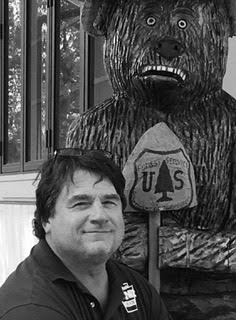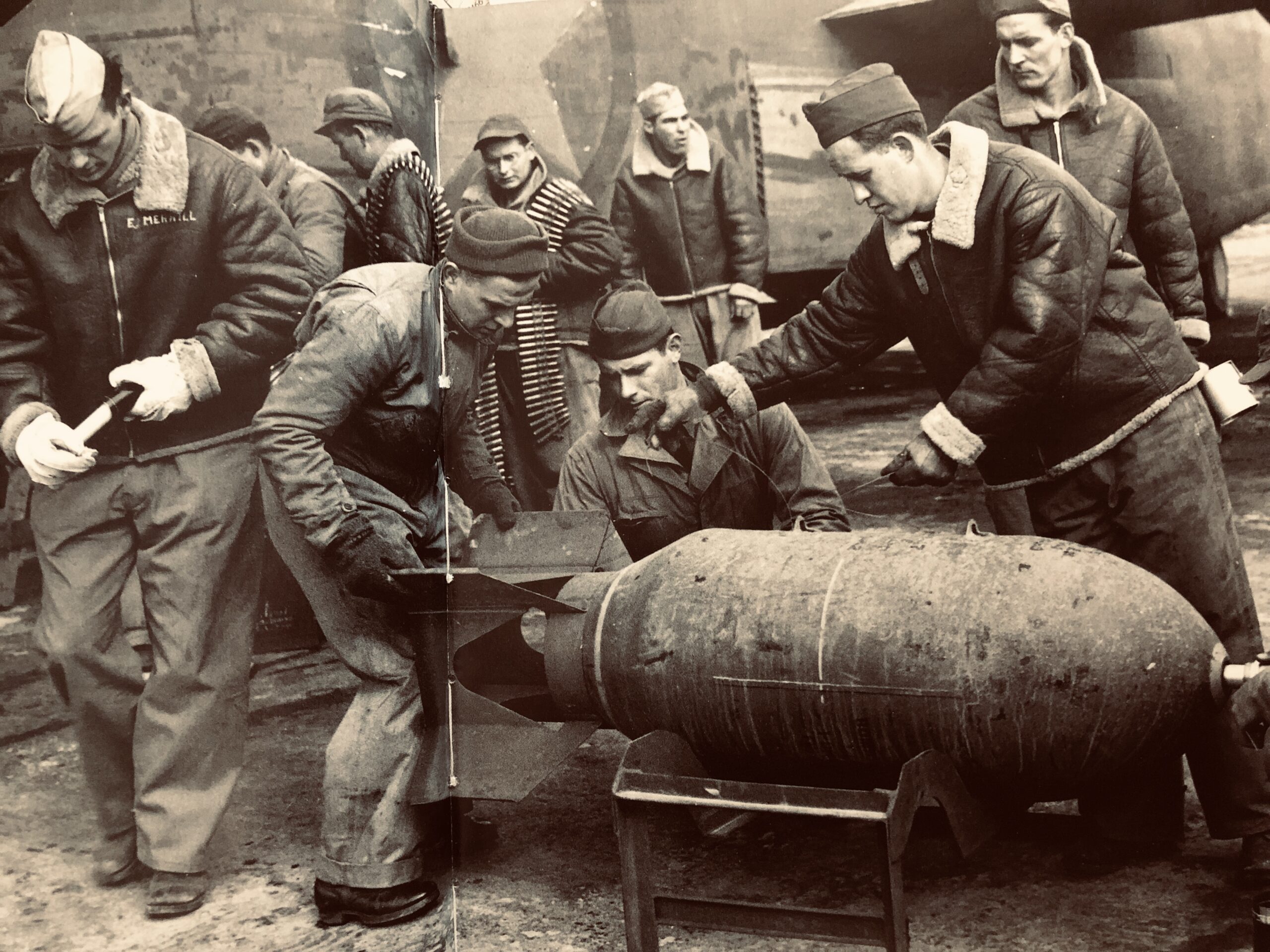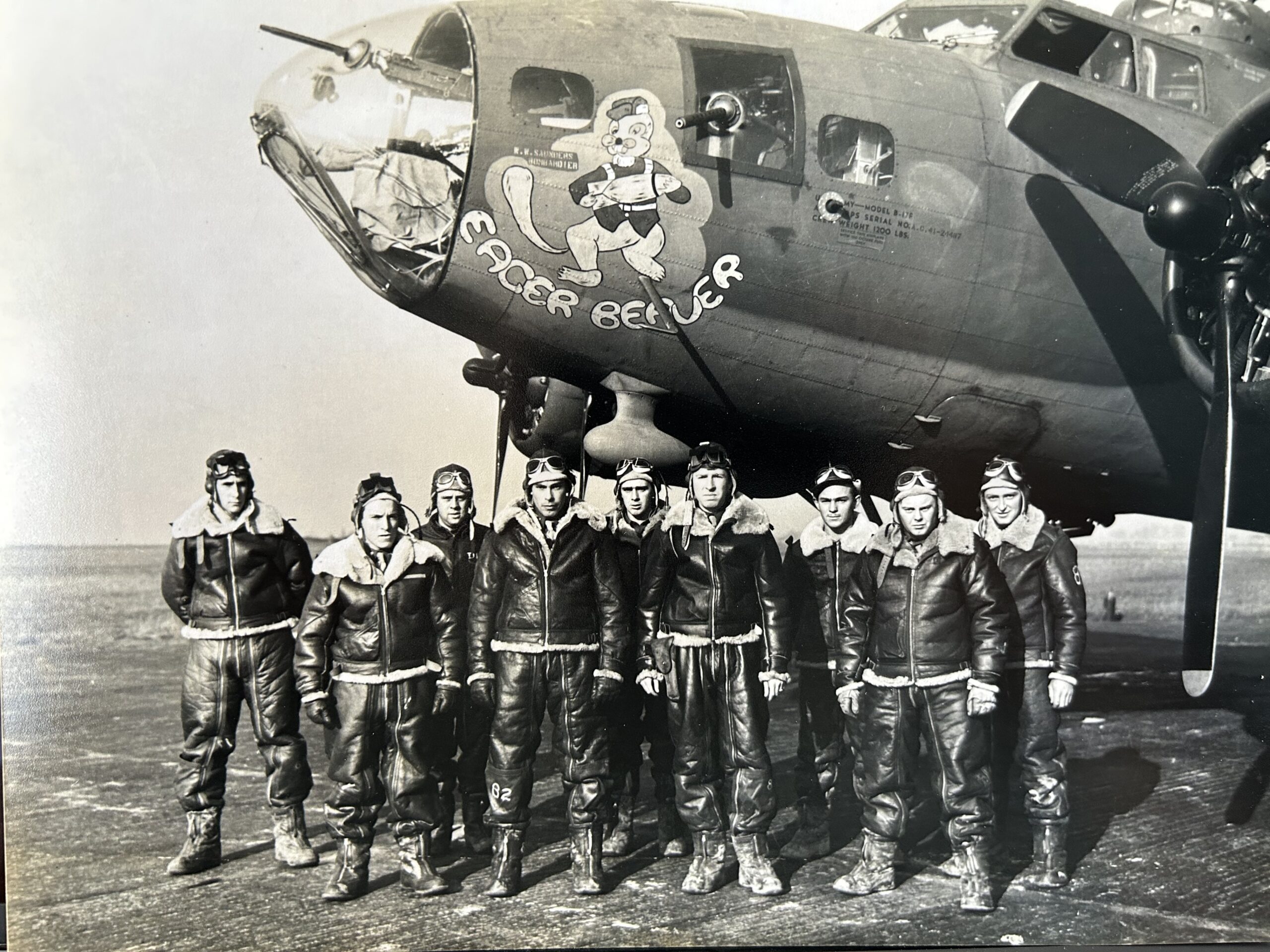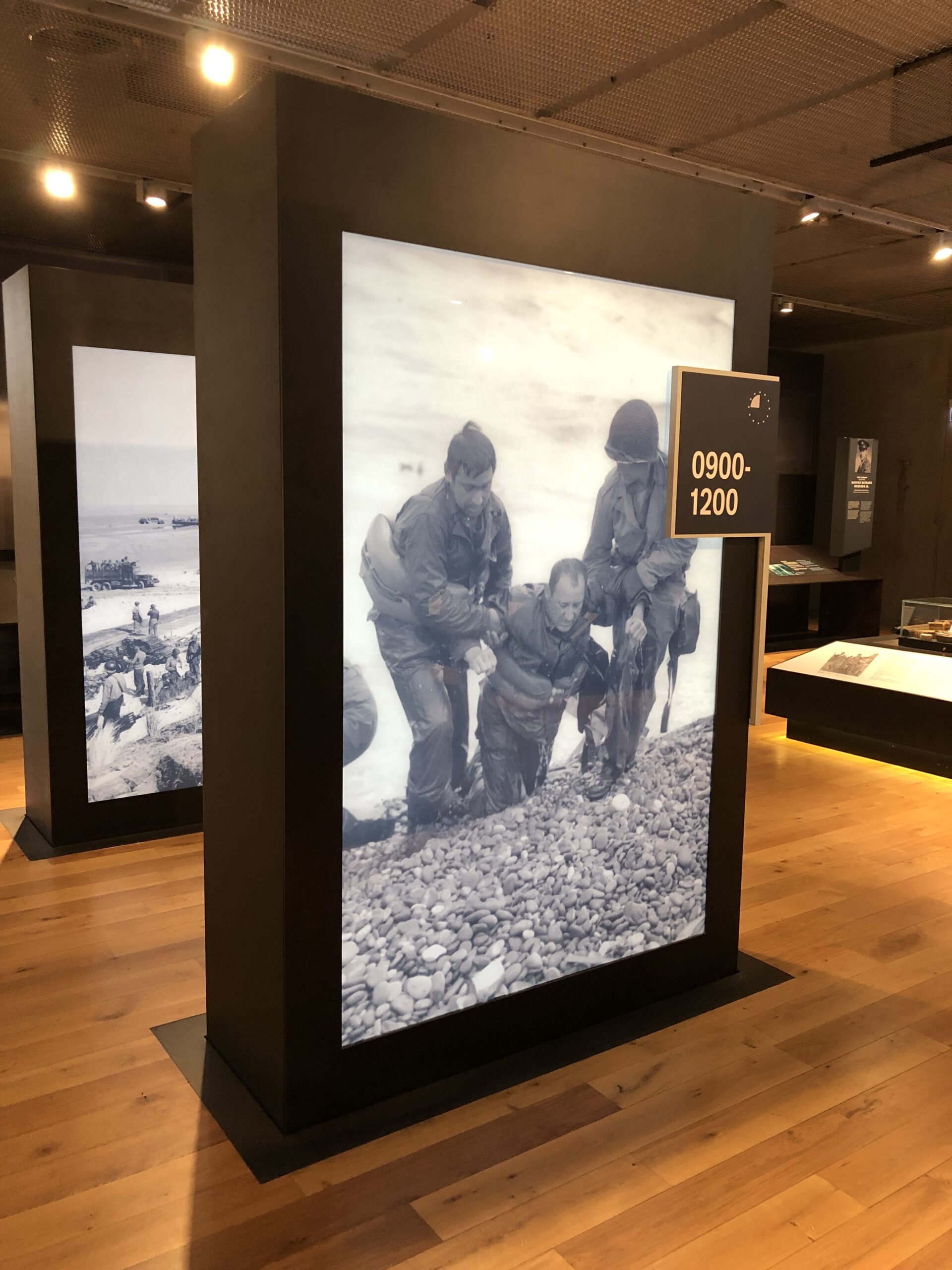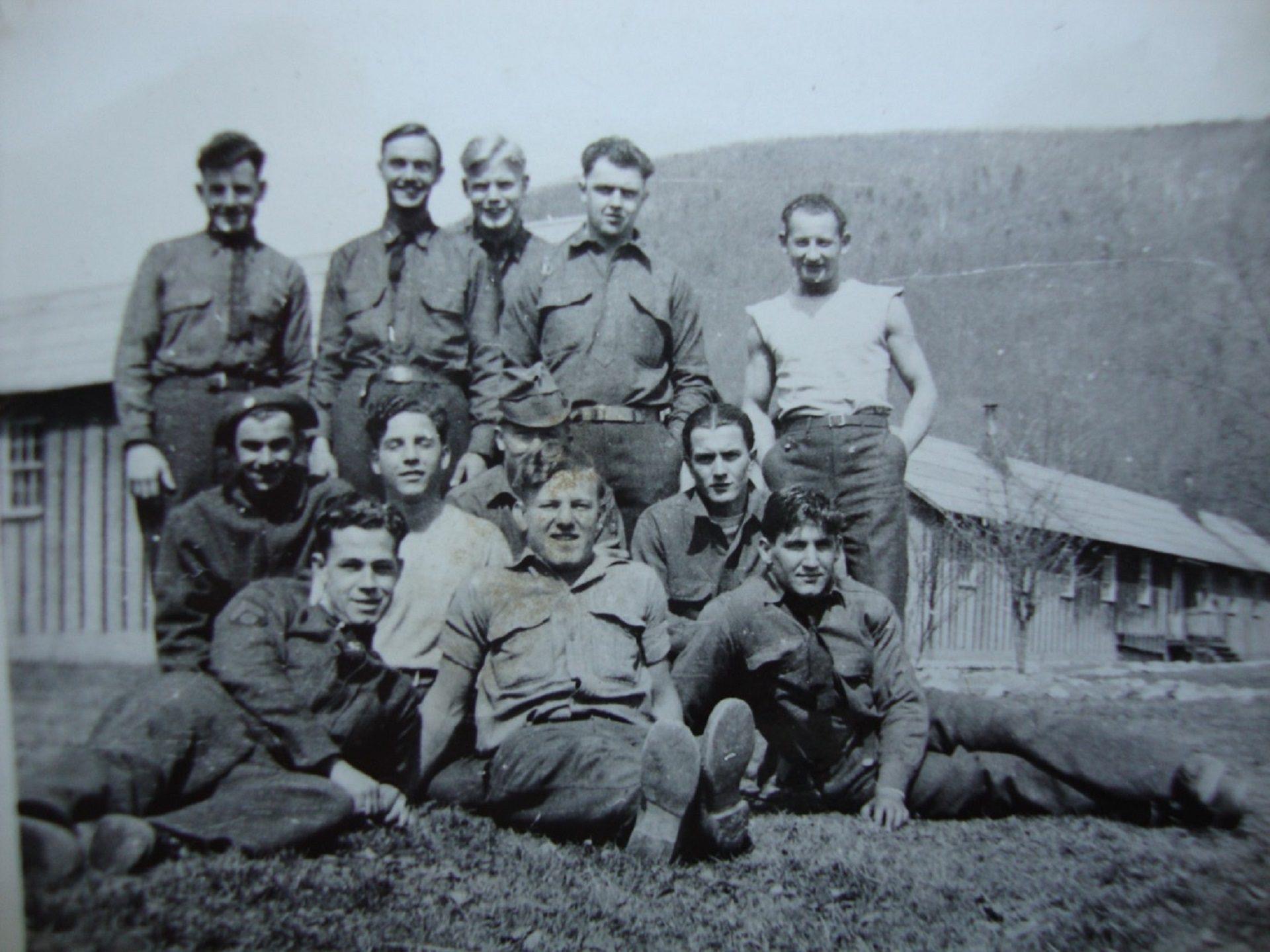Uncle Elwood was born on March 25th, 1920, near Laceyville, PA, and sprouted up on the family farm with his two brothers and the cows and the crops. He ended up smallish, but fearless, and with a big smile and a bigger heart. When his farm work was done, young Elwood loved to hunt, fish, and spend time enjoying the fields and forests that had sustained his family.
After the attack on Pearl Harbor in 1941, Elwood, like many young men and women, felt drawn to serve. He enlisted in the U.S. Army Air Force, and after stateside training, found himself in Thurliegh, England, amidst hundreds of other brave young men from around the country who had been trained to fly missions on the B17 Flying Fortress aircraft that were based in southeast England… just across the English Channel from German-occupied France.
“I was real familiar with guns and shooting and machinery, having grown up on the farm,” he told me. “Most of us rural kids were.”
Elwood, because he was so comfortable with the operation and maintenance of firearms and things mechanical, and because he could fit in the tiny tail gunner’s compartment of a B17, was a natural for the job.
Image: Young men prepping a B17 prior to a mission. Photo from Jim Hyland’s personal collection.
The B17 Flying Fortress truly was aptly named. To defend her crew and bomb load, the B17 carried 10 to 13 Browning .50 caliber machine guns that were capable of firing over 500 rounds per minute each.
While on his assigned plane, the “Eager Beaver” (stored post-war in Montoursville for many years), Uncle Elwood sat in the tail section on a leather bicycle-type seat facing the rear. His twin Brownings were mounted just in front of him, and he aimed at attacking enemy planes through the square supposedly bulletproof glass windows above the guns. Temperatures in the aircraft would often drop below minus 30 degrees Fahrenheit, and missions would last up to ten hours.
Image: A group shot of the Eager Beaver. Uncle Elwood is pictured third from the right. Photo courtesy of Jim Hyland.
On April 17th, 1943, Elwood was “pinch-hitting” as a tail gunner on the “Little Savage,” another plane in his squadron who had lost their tail gunner on a previous mission. Yeah, no comfort there! Anyway, the mission at hand was to bomb the Focke-Wulf airplane plant at Bremen, Germany, where the FW-190 fighter airplane was manufactured. The FW-190 is considered by many aviation historians to be the finest fighter plane of WW2. The Germans defended the factory heavily, and the Little Savage was the only one out of six in its squadron to make it back to England.
Elwood was knocked unconscious when a chunk of his bulletproof glass was blasted into his forehead by a Luftwaffe machine gun. But the Little Savage sputtered home with two of four engines shot out, a piece of the wing and rudder missing, and over 2000 holes in the fuselage.
Image: A photo showing the Tail Gunner position. Free use image from WorldWarPhotos.com.
Undaunted by his experiences, in one month he was out of the hospital and at it again.
This time, he was filling in as a right-side gunner on an unnamed B-17 that was flying to bomb the naval yard at Wilhelmshaven, Germany, on the North Sea. It was his 25th mission, after which he would have been eligible to go home to the beloved Bradford County farm.
As the plane approached the target, enemy fighters swarmed relentlessly, and flak cannons boomed from below. A flak shell made a direct hit on Elwood’s plane, sending it into a flat spin. Elwood barely got out in time enough to open his parachute, having been pinned to the interior by centrifugal force. A minute later, he was on the ground in Wilhelmshaven, near the town square, unfortunately. He was quickly pistol-whipped, thrown into a wagon, then imprisoned. He would have to endure two years of starvation and brutality until brave Americans and Brits fought their way across France and Germany to free him in the spring of 1945. Uncle Elwood married Mabel, the English nurse that took care of him while he was in the hospital in London following his injuries over Bremen. She waited for him, not knowing if he was dead or alive.
Hundreds of the young men fighting across France and Germany were formerly Civilian Conservation Corps (CCC Boys) from camps in the Pennsylvania Wilds. In fact, there is a picture of one of them at the American military museum in Normandy, France, and it is life-sized and very moving. He is being pulled from the surf after his landing craft had been sunk by enemy gunfire on D-Day plus one.
His name is Nick Russin, and prior to joining the Army, he had been in CCC camps at Coudersport and Darling Run/Asaph.
Image: Nick Russin’s photo is featured in the American Military Museum in Normandy, France.
I was fortunate to speak to quite a few CCC boys during my career as a DCNR forester. One remarkable man named Ted Niedzwieki had been in the CCC camp at Dyer Farm, in Potter County. He ended up as a navigator on a B29 Superfortress and flew bombing runs over mainland Japan. He became very emotional when he told me that four of the five really good buddies he had made at the Dyer Camp had never made it home from WW2.
Mr. Niedzwiecki retired after 24 years of service as a B29 master sergeant with the 20th Air Force on the island of Saipan, one of the islands that was captured at high cost by young Americans in the Pacific theater during WW2. He lived to age 95, and passed on in 2017.
Those are the stories of the price just a few of our fellow Pennsylvanians paid for the lifestyle we enjoy. But there are many others. Some stories are still unfolding today overseas, and many are gone without ever having been told. Uncle Elwood didn’t tell his until his last years.
We’ve all heard the cliché “freedom isn’t free”, but all Americans must continue to understand these simple words. The next time you’re out in our forests, remember that the solitude, beauty, serenity, and peace you feel was, and is presently paid for with the strength, sweat, bravery, and blood of those of our society who defend our great country with their lives.
Image: Nick Russin at the Asaph CCC Camp. Photo courtesy of Jim Hyland.
About the author, Jim Hyland:
Jim Hyland worked his entire career as a DCNR forester in the beautiful north central region of the state. There, he forged a strong appreciation of the people and the woodlands they value and enjoy. Most recently, he was the district forester in the Tioga State Forest, headquartered in Wellsboro, Tioga County. He retired in October 2023. A native of Shenandoah, Schuylkill County, Hyland started his career with the Bureau of Forestry as a Penn State University intern in the Rothrock State Forest District, Centre County. After college, he began working as a forester in Tiadaghton State Forest District, Lycoming County. He was later promoted to Tiadaghton Assistant District Manager and spent two years directing state forest maintenance and recreational programs in the district. Hyland has also served as a Forest Program Specialist with the Bureau’s Division of Operations and Recreation, with emphasis on the Pennsylvania Wilds Region. He was active with the Bureau’s History Committee, and with a love of writing has penned many articles for local newspapers and DCNR publications documenting the lore of north central Pennsylvania and his native coal region, among other topics. Also, he has served as a firefighter and public information officer on many firefighting assignments in the Western U.S. As head of one of 20 state forest districts across the state, Hyland oversaw forest- growth management, personnel coordination, infrastructure maintenance, recreation, and fire prevention and suppression. He also managed service foresters who provide support, direction and technical assistance to private forest landowners. Hyland holds a bachelor’s degree in Forest Management from The Pennsylvania State University. An avid outdoorsman, Hyland enjoys nature writing, woodworking, history, backcountry canoeing and hiking, hunting, fishing, and any type of adventure. Parents of three grown children, he and his wife, Sherry, reside in rural Lycoming County with their Labrador, Finnegan, as well as Ralphie, the calico cat and Kaiser, the African gray parrot.
